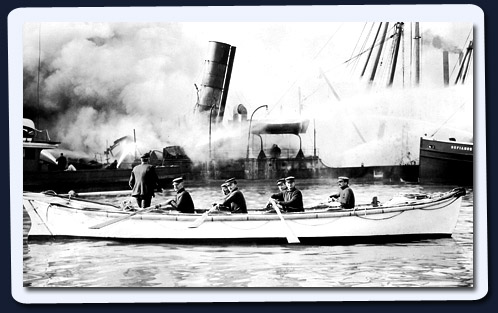Europe’s rugged coastline for centuries was a haven for wreckers and smugglers, and these activities reached a peak in the eighteenth century. Shipwrecks were thought to be fair game across all sections of society with hundreds of people following a troubled ship at times along the coast in anticipation of a rich harvest. Immigrants to the United States brought along these traditions.
Wreckers in the early nineteenth century built the town of Key West. When ships foundered, the first wrecker on the scene—from a flotilla of streaking schooners—was designated the master of that wreck and ran the operation. Later, the salvors received their cut from a share of the auction proceeds or “in kind.” Wrecker abuses led to calls for reform, and this rough-and-tumble world finally became regulated as it eventually matured into a competitive business-for-hire. However, the risks continued unabated by having to work in the same capricious seas that caused the many deaths and destruction in the first place.
The United States had its share of salvors from the mid-eighteenth to twentieth century: from Captains Merritt (New York) and Scott (Connecticut) on the East Coast to James Dunham (Chicago), Tom Reid (Great Lakes), and Thomas P.H. Whitelaw on the West Coast. The wrecker who achieved the greatest success, respect, and publicity was Captain Whitelaw (1847-1932). His working life spanned the era from wooden clipper ships to today’s huge steel-hulled steamships.
In his San Francisco yard, Whitelaw pulled apart tall windjammers and stubby schooners which had seen their last days upon the seas. He sold them piecemeal, along with the remains of steamers that his crews couldn’t refloat. Whether he was on the waterfront or studying a wrecked ship, Whitelaw was known for his trademark bowler hat, three-piece suit, and flowing, white beard.
Over time, Whitelaw became one of the largest ship owners on the coast—including large wrecking vessels and freight schooners—as well as owning huge warehouses filled with salvaged masts, spars, rigging, and even anchors. These operations became huge used-parts shops for ships. Internationally recognized, Whitelaw was regarded as “The Master Wrecker” and “The Great Wrecker of the Pacific.”Ranging far from his San Francisco base, his ventures ranged from Mexico upward along the entire West Coast to British Columbia and the Bering Sea. Countries from Europe to Asia and the U.S. government called upon him for his expertise.
| THE RAGING SEA | TREASURE SHIP | SENTINEL OF THE SEAS | TAKING THE SEA | TALES OF THE SEVEN SEAS |
|
Taking the Sea: Perilous Waters,
Sunken Ships, and the
True Story
of the Legendary Wrecker Captains

This book showcases the heart-beating salvages conducted by the important wreckers. The tales of what happened to these wreck-masters, passengers, and the ships in savage seas match the best fiction of the Sargasso Sea. We see how history and innovation march over the decades and completely change the maritime world—while as Whitelaw observed, “A terrible, always hungry monster, with long white teeth is the sea. It is a smiling witch one day—a terrible monster the next.”